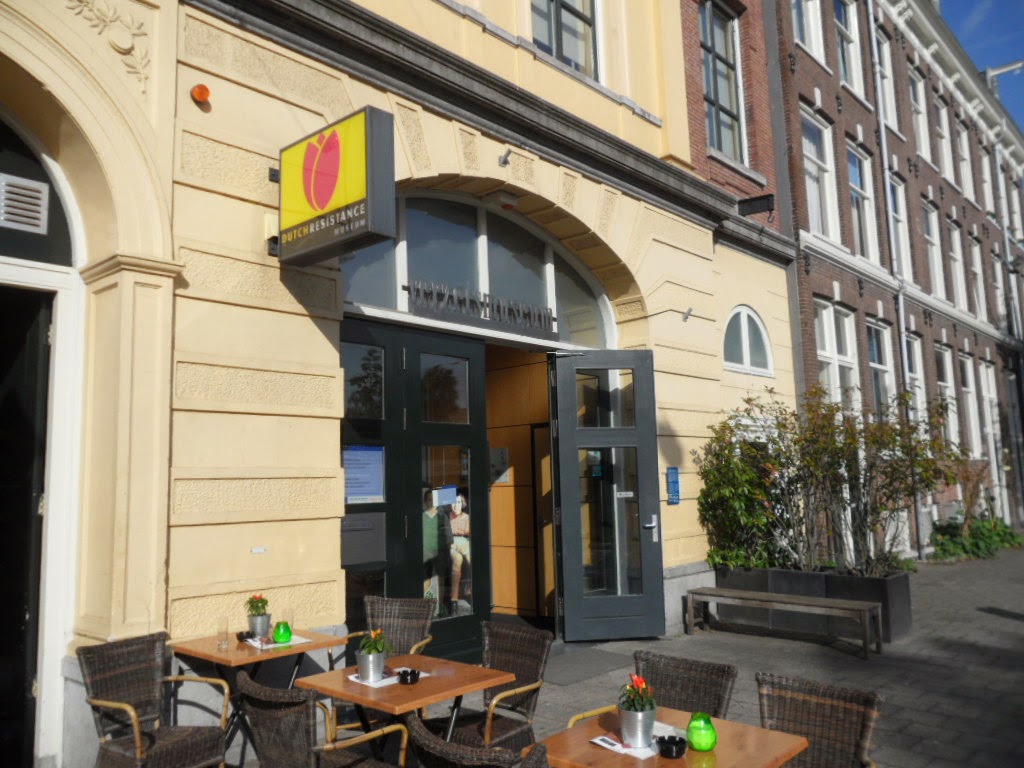Site Seeing in Amsterdam - Friday
 |
| View from the observation deck at the top of the hotel - Ramada Apollo. |
 |
The sun is out - a beautiful day and view along a canal.
The Dutch Resistance Museum
This was a wonderful museum located in the Plantage area near the zoo. The permanent exhibit of the museum recreates the atmosphere of the streets
of Amsterdam during the German occupation of the WWII. Big photographs,
old posters, objects, films and sounds from that horrible time, help to
recreate the scene. The background of the Holocaust is visualized to the
visitor. This is an exhibition about the everyday life during that
time, but also about exceptional historical events, resistance of the
population against the Nazis and heroism. There was a special exhibit "To the Farms" telling the story of the children who were sent to the countryside during the "Hunger Winter" when children and adults were starving in Amsterdam. Tulip bulbs were sometimes the only food. The exhibit was very moving with artifacts and videos of some the grown up children who experienced it. There was also an excellent children's exhibit telling the stories of 4 children - Eva, Jan, Nelly and Henk. It is well worth looking at this link.
http://www.verzetsmuseum.org/museum/en/the-dutch-resistance-museum-junior
|

 |
| A display from the Junior Museum. |
 |
| Junior Museum |
 |
| Junior Museum display about propaganda. |
 |
| Installed in 1993, this
work by Jan Wolkers is composed of broken glass covering the ground over
ten square meters, reflecting the sky, symbolizing that "the heavens
has never been broken" by what happened at Auschwitz . |
The Rembrandt House
The house where Rembrandt lived between 1639 and 1658 is a museum:
Museum het Rembrandthuis or the Rembrandt House Museum. The building was
constructed in 1606 and 1607 in what was then known as the Sint
Anthonisbreestraat. The street did not come to be called the
Jodenbreestraat until later. The house was built on two lots in the
eastern part of the city. Many rich merchants and artists settled in
this new part of town. The house can clearly be seen on a bird’s eye
view map dating from 1625. It is a substantial two-storey dwelling house
with a stepped gable. In about 1627-28 the house was drastically
remodelled. It was given a new façade, a triangular corniced
pediment—the height of modernity at the time—and another storey was
added. In 1639 Rembrandt signed a contract governing the payment for the
purchase of the house in the Breestraat. The purchase price was thirteen
thousand guilders, a huge sum, which he could not come up with in its
entirety. He was, however, allowed to pay it off in instalments. At this
time Rembrandt had already established his reputation as an artist. In
the same year he bought the house, he was awarded the prestigious
commission to paint the Night Watch. Although he was earning a lot of
money, Rembrandt was unable—or unwilling—to pay off the mortgage. This
was eventually to bring about his financial downfall. Between 1652 and
1656 Rembrandt made frantic attempts to get his hands on money to pay
off his debt. He did not succeed and was forced into bankruptcy. In 1656
Rembrandt’s property was inventoried for the benefit of his creditors,
and his household effects and collection of art and curiosities were
sold. The house was auctioned in 1658 and fetched something over eleven
thousand guilders. Rembrandt moved to a small rented house on the
Rozengracht, where he lived until his death in 1669.

 |
| One of my favorite parts - the explanation of how the paint was made. Painter were chemists an bought minerals and materials from all over the world to make the various colors. |
 |
| A sign that things are different in Amsterdam! |
 |
| Lunch at Restaurant Cafe in De Waag. The Waag (Weigh House) is a 15th-century building on Nieuwmarkt square in
Amsterdam. It was originally a city gate and part of the walls of
Amsterdam. The building has also served as a guildhall, museum, fire
station and anatomical theatre, among others. |
 |
The Waag
|












